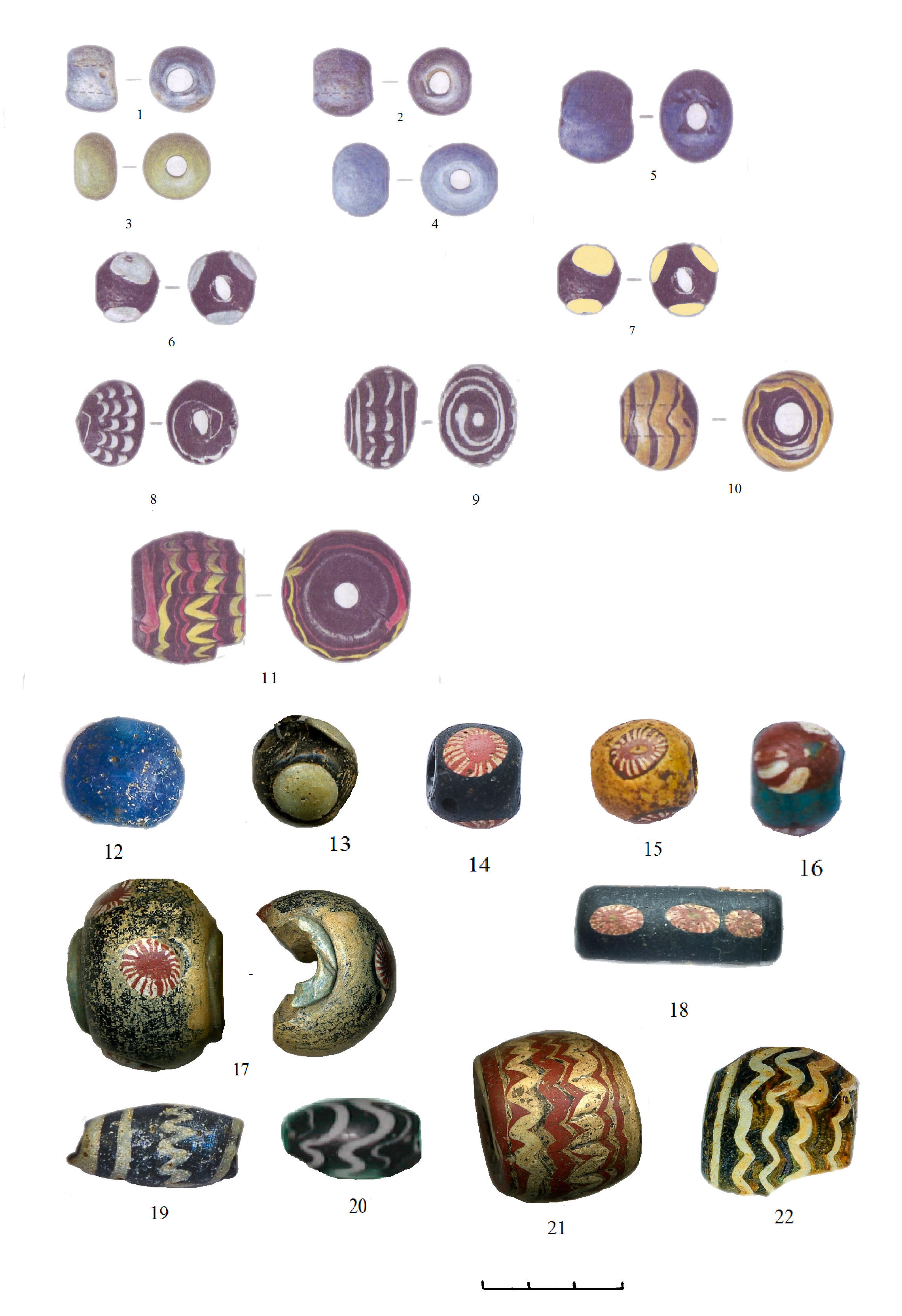GLASS PENDANTS FROM THE BURIALS OF NOMADS OF THE 13TH–14TH CENTURIES
DOI:
https://doi.org/10.24852/2587-6112.2021.4.141.148Keywords:
archaeology, medieval nomads, the Golden Horde, glass pendants, adornmentsAbstract
Glass pendants originating from the nomad burials of the 13th–14th centuries form a most numerous category of the finds. A total of 63 items have been studied. The basis for the systematization of the beads is such features as the manufacturing technology, as well as the ornamentation, shape, size and color. Pendants, as а part of the archaeological complex, are an important element of the reconstruction of the costume. The territory of the Lower Volga region features well-preserved burials, in a number of which a certain order in the arrangement of pendants has been traced, and the method of wearing is being reconstructed. Pendants decorated a woman's headdress, formed the center of a necklace, were used in the form of amulets, and also served as a decoration for a purse or bag. The men's costume of the Horde is characterized by the use of large blue or ornamented pendants as retainers for weapon straps, and purse decoration.
References
REFERENCES
Alikhova, A. E. 1948. In Gotie, Yu. V., Tsyganov, N. F., Kotkov, Yu. A. (eds.). Arkheologicheskii sbornik. (Archaeological Collection of Papers. 1. Saransk: “Mordovskoe knizhnoe izdatel’stvo” Publ., 212−258 (in Russian).
Busiatskaia, N. N. 1976. In Smirnov, A. P. (ed.). Srednevekovye pamiatniki Povolzh’ia (Medieval Sites from the Volga Region). Moscow: “Nauka” Publ., 73–107 (in Russian).
Valiulina, S. I. 2005. Steklo Volzhskoi Bulgarii (po materialam Biliarskogo gorodishcha) (Glass of Volga Bulgaria: by materials of the Bilyar Fortified Settlement). Kazan: Kazan State University (in Russian).
Galkin, L. L. 1984. In Sovetskaia Arkheologiia (Soviet Archaeology) (2), 213–221 (in Russian).
Zhukovskaya, N. L. 2002. Kochevniki Mongolii. Kul’tura. Traditsii. Simvolika (Nomads of Mongolia. Culture. Traditions. Symbolism). Moscow: “Nauka” Publ. (in Russian).
Karimova, R. R. 2013. Elementy ubranstva i aksessuary kostiuma kochevnikov Zolotoi Ordy (tipologiia i sociokul'turnaia interpretatsiia) Elements of dressing and costume accessories of Golden Horde nomads (typology, social and cultural interpretation). Series: Arkheologiia evraziiskikh stepei (Archaeology of the Eurasian Steppes) 7. Kazan: Institute of History named after Shigabuddin Mardzhani, Tatarstan Academy of Sciences; Samara Municipal Institute for Public Administration (in Russian).
Levashova, V. P. 1965. In Kiselev, S. V. (ed.). Drevnemongolskie goroda (Early Mongol Towns). Moscow: “Nauka” Publ., 297–307 (in Russian).
L’vova, Z. A. 1959. In Artamonov, M. I. (ed.). Materialy i issledovaniia po arkheologii SSSR (Materials and Research in the USSR Archaeology) 75. Moscow; Leningrad: the USSR Academy of Sciences, 307−332 (in Russian).
Mongait, A. L. 1955. In Materialy i issledovaniia po arkheologii drevnerusskikh gorodov (Materials and Studies on the Archaeology of Old Russian Towns) 4. Series: Materialy i issledovaniia po arkheologii SSSR (Materials and Studies in Archaeology of the USSR) 49. Moscow: Academy of Sciences of the USSR (in Russian).
Mys'kov, E. P. 2015. Kochevniki Volgo-Donskikh stepei v epokhu Zolotoi Ordy (Nomads of the Volga-Don Steppes in the Golden Horde Period). Volgograd: “RANKhiGS” Publ. (in Russian).
Mosheeva, O. N. 2008. In Rossiiskaia Arkheologiia (Russian Archaeology) (4), 23−33 (in Russian).
Poluboiarinova, M. D. 1988. In Fedorov-Davydov, G. A. (ed.). Gorod Bolgar. Ocherki remeslennoi deiatel’nosti (City of Bolgar. Essays on Handicrafts). Moscow: “Nauka” Publ., 151–219 (in Russian).
Poluboiarinova, M. D. 2006. In Rossiiskaia Arkheologiia (Russian Archaeology) (4), 57−72 (in Russian).
Sazonova, M. V. 1970. In Kislyakov, N. A. (ed.) Traditsionnaia kul'tura narodov Perednei i Srednei Azii (Traditional Culture of the Peoples of Western and Central Asia). Series: Sbornik Muzeya Antropologii i Etnografii. T. XXVI (Anthropology and Ethnography Museum Collection) 26. Saint Petersburg: “Nauka” Publ., 113−142 (in Russian).
Fekhner, M. V. 1959. In Rybakov, B. A. (ed.). Ocherki po istorii russkoi derevni X—XIII vv. (Essays on History of the Russian Village of 10th—13th Centuries). Series: Proceedings of the State Historical Museum 33. Moscow: “Sovetskaia Rossiia” Publ., 149–224 (in Russian).
Shchapova, Yu. L. 1956. In Artsikhovskii, A. V., Kolchin, B. A. (eds.). Trudy Novgorodskoi arkheologicheskoi ekspeditsii (Proceedings of the Novgorod Archaeological Expedition) 1. Series: Materialy i issledovaniia po arkheologii SSSR (Materials and Research in the USSR Archaeology) 55. Moscow: Academy of Sciences of the USSR Publ., 165–179 (in Russian).
Shchapova, Yu. L. 1984. In Sovetskaia Arkheologiia (Soviet Archaeology) (2), 222–225 (in Russian).
Shchapova, Yu. L., Likhter, Yu. A., Saracheva, T. G., Stolyarova, E. K. 2007. Morfologiia drevnostei (Morphology of Antiquities) 4. Moscow: “KDU” Publ. (in Russian).

Downloads
Published
How to Cite
Issue
Section
License
Copyright (c) 2021 N. P. Kuryshova

This work is licensed under a Creative Commons Attribution-NonCommercial 4.0 International License.







